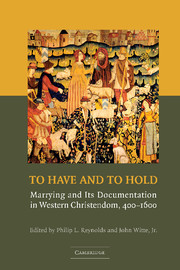Book contents
- Frontmatter
- Contents
- List of Contributors
- Preface and Acknowledgments
- List of Abbreviations
- 1 Marrying and Its Documentation in Pre-Modern Europe: Consent, Celebration, and Property
- 2 Marrying and Its Documentation in Later Roman Law
- 3 Marrying and the Tabulae Nuptiales in Roman North Africa from Tertullian to Augustine
- 4 Dotal Charters in the Frankish Tradition
- 5 Marriage and Diplomatics: Five Dower Charters from the Regions of Laon and Soissons, 1163–1181
- 6 Marriage Agreements from Twelfth-Century Southern France
- 7 Marriage Contracts in Medieval England
- 8 Marriage Contracts and the Church Courts of Fourteenth-Century England
- 9 Marrying and Marriage Litigation in Medieval Ireland
- 10 Marriage Contracts in Medieval Iceland
- 11 Contracting Marriage in Renaissance Florence
- 12 Marital Property Law as Socio-Cultural Text: The Case of Late-Medieval Douai
- 13 Marriage Contracts, Liturgies, and Properties in Reformation Geneva
- Index
3 - Marrying and the Tabulae Nuptiales in Roman North Africa from Tertullian to Augustine
Published online by Cambridge University Press: 12 September 2009
- Frontmatter
- Contents
- List of Contributors
- Preface and Acknowledgments
- List of Abbreviations
- 1 Marrying and Its Documentation in Pre-Modern Europe: Consent, Celebration, and Property
- 2 Marrying and Its Documentation in Later Roman Law
- 3 Marrying and the Tabulae Nuptiales in Roman North Africa from Tertullian to Augustine
- 4 Dotal Charters in the Frankish Tradition
- 5 Marriage and Diplomatics: Five Dower Charters from the Regions of Laon and Soissons, 1163–1181
- 6 Marriage Agreements from Twelfth-Century Southern France
- 7 Marriage Contracts in Medieval England
- 8 Marriage Contracts and the Church Courts of Fourteenth-Century England
- 9 Marrying and Marriage Litigation in Medieval Ireland
- 10 Marriage Contracts in Medieval Iceland
- 11 Contracting Marriage in Renaissance Florence
- 12 Marital Property Law as Socio-Cultural Text: The Case of Late-Medieval Douai
- 13 Marriage Contracts, Liturgies, and Properties in Reformation Geneva
- Index
Summary
In his Life of St. Augustine, Possidius, Bishop of Calama, observed that Augustine as bishop was reluctant to involve himself in certain worldly activities, such as arranging marriages, writing letters of recommendation for men entering military careers, and accepting dinner invitations. The reasons for this reticence, which Possidius attributed to the influence of Bishop Ambrose, were as follows: “lest spouses quarrel and curse the one who had brought them together … lest the man recommended for the military turn out badly and blame his backer; and lest the habit of temperance be lost through frequent attendance at banquets with fellow townsmen.” In the case of episcopal involvement in marriages, Possidius records one important qualification: “but he also said that when spouses were in agreement, the bishop should, if asked, be present so that their compacts or agreements might be ratified or blessed.”
Possidius's description of Augustine's (somewhat qualified) interest in Christian weddings provides a helpful entry into the topic of this essay. What precisely do we know about the ceremony of marriage among Christians in North Africa in the time of Augustine? The question is important not only for the history of liturgy but also for an understanding of Augustine. No Christian writer has exerted greater influence on the development of the Western theology of marriage than Augustine. Whereas much scholarly discussion has been devoted to Augustine's theological understanding of the “sacramentality” of marriage and, more recently, to his views of sexuality and sin, comparatively little attention has been paid to the specific ritual or liturgical practices that may have accompanied the formation of a Christian marriage as Augustine knew it.
- Type
- Chapter
- Information
- To Have and to HoldMarrying and its Documentation in Western Christendom, 400–1600, pp. 95 - 113Publisher: Cambridge University PressPrint publication year: 2007
- 4
- Cited by



